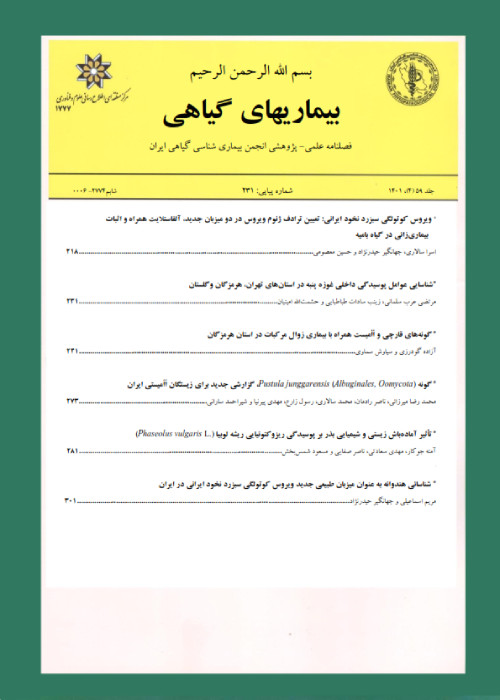Surveying virulence of the causal agent of wheat stripe rust (Puccinia striiformis f. sp. tritici) and determining reaction of commercial wheat cultivars over the past decade in Fars, Iran
Abstract:
Annual survey for monitoring of reaction of commercial wheat cultivars to stripe rust disease is very important after their introduction and extensive cultivation. The host materials surveyed included the standard differential cultivars for stripe rust along with 24 and three respectively commercial bread and durum wheat cultivars. This study was accomplished in selected wheat fields of six regions of Fars province including Zarghan, Marvdashat, Fassa, Mammassani, Darab and Eghlid during 2003- 2005 and in two stripe rust nurseries in Zarghan and Mammassani during 2003- 2013. The results showed that the resistance of 12 cultivars including Chamran, Shirodi, Shiraz, Darab 2, Falat, Star, kavir, Zarin, Shahriar, Alvand, Alemot and Bahar was overcome by stripe rust during or before the last decade. Yavarous and several recently introduced cultivars including Zareh, Mihan, Siravan, Chamran 2, Ophogh, Behrang and Shabrang have conferred moderately to intermediate resistance reaction to the disease. The cultivars Sivand, Parsi, Pishgham, Marvdasht and Aflak showed a range of moderately resistance to moderately susceptible reaction. The response of Pishtaz varied from moderately susceptible to resistance. Nicknejad has shown to have high level of resistance since its long time introduction. Decrease or changes in the resistance of some of the cultivars can be attributed to changes in stripe rust races, weather conditions and environmental factors. In this regard among the differential cultivars, virulence was almost present for Yr2, Yr6, Yr7, Yr9, Yr17, Yr25, Yr26, Yr27, YrA and YrSU. Current research indicates that annual survey on responses of commercial wheat cultivars to stripe rust together with monitoring of pathogen virulence factors in Fars province are very necessary. These information not only can effectively aid in giving on-time warning to replace susceptible cultivars and to use effective control measures to reduce the loss of the disease, but also can play an important role in short and long time wheat breeding programs.
Keywords:
Wheat , Stripe rust , Response (Reaction) , Resistance , Susceptibility , Virulence , Race , Pathotype
Language:
Persian
Published:
Iranian Journal of Plant Pathology, Volume:52 Issue: 3, 2017
Pages:
297 to 316
magiran.com/p1646654
دانلود و مطالعه متن این مقاله با یکی از روشهای زیر امکان پذیر است:
اشتراک شخصی
با عضویت و پرداخت آنلاین حق اشتراک یکساله به مبلغ 1,390,000ريال میتوانید 70 عنوان مطلب دانلود کنید!
اشتراک سازمانی
به کتابخانه دانشگاه یا محل کار خود پیشنهاد کنید تا اشتراک سازمانی این پایگاه را برای دسترسی نامحدود همه کاربران به متن مطالب تهیه نمایند!
توجه!
- حق عضویت دریافتی صرف حمایت از نشریات عضو و نگهداری، تکمیل و توسعه مگیران میشود.
- پرداخت حق اشتراک و دانلود مقالات اجازه بازنشر آن در سایر رسانههای چاپی و دیجیتال را به کاربر نمیدهد.
دسترسی سراسری کاربران دانشگاه پیام نور!
اعضای هیئت علمی و دانشجویان دانشگاه پیام نور در سراسر کشور، در صورت ثبت نام با ایمیل دانشگاهی، تا پایان فروردین ماه 1403 به مقالات سایت دسترسی خواهند داشت!
In order to view content subscription is required
Personal subscription
Subscribe magiran.com for 70 € euros via PayPal and download 70 articles during a year.
Organization subscription
Please contact us to subscribe your university or library for unlimited access!


